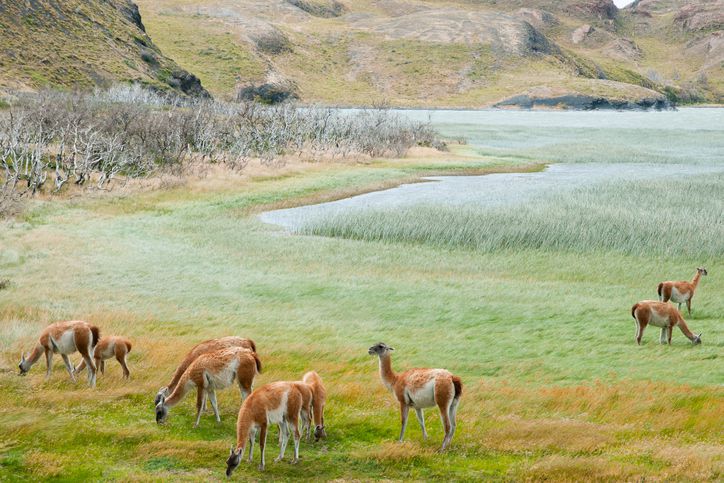A wild camelid native to South America, the guanaco is a common sight on trips to the altiplano of Bolivia, Chile and Peru as well as the grasslands of Patagonia. But what do guanacos eat and how do they live in conditions so extreme that few other species can survive?
What exactly are guanacos?
Guanacos are one of four camelid species that live in South America. While you’ve probably heard of the llama, the guanaco is its wild ancestor and was domesticated thousands of years ago to be used for its wool and as a pack animal. Similarly, the vicuña, another type of camelid found only in the Andes Mountains, is the wild version of the alpaca, another domesticated camelid.
What do guanacos look like?
Measuring up to 3ft. 11in. (1.2m) at the shoulder, guanacos are one of the largest wild mammals in South America, with long legs and a long neck. Their wool is generally deep brown or cinnamon in color, while their underbelly and neck are white, allowing them to blend in well with their surroundings when living on barren grassy plains or in the dusty altiplano. They also have large ears and thick eyelashes to protect them from any grit and dust that is blown in their direction by the wind.
What do guanacos eat?
Like cattle and sheep, guanacos are ruminants, which means that their digestive system is split into three chambers to allow them to extract all vital nutrients from the plant matter that they eat. The food is fermented to become cud and then re-chewed to aid the digestion process.
 Guanacos live in parts of South America where little vegetation grows and similar to camels, they don’t actually need to drink water – instead, they get all the moisture they require from the grass and plants that make up their diet.
Guanacos live in parts of South America where little vegetation grows and similar to camels, they don’t actually need to drink water – instead, they get all the moisture they require from the grass and plants that make up their diet.
What’s even more interesting when answering the question, “what do guanacos eat” is the fact that in the Atacama Desert, guanacos have adapted to the extreme conditions of the world’s driest desert by eating the flowers of cacti and the lichens that grow on the plant and obtaining the necessary liquid from this source. Clever!
How do guanacos live?
If you ever come across a guanaco on a trip to South America, you’ll likely notice how they live in large herds, normally consisting of at least ten females and their young, all accompanied by a dominant male. Young and bachelor males live in separate herds that can reach up to 50 individuals.
These herds are a form of defense against their main predator, the puma. However, man has become the more deadly predator, as numbers of the animal have declined from an estimated 50 million when the Europeans first arrived in South America to around two million today.
When do guanacos reproduce?
The mating season for guanacos occurs once per year and generally takes place between early December and early January. Their gestation period is 11.5 months, so if you’re planning a trip to Patagonia you can expect to spot furry chulengos (baby guanaco) from November onwards.
 Chulengos can stand up just a few minutes after being born, an essential skill to help them escape predators. Mothers are known to be particularly aggressive towards predators, spitting and kicking any animals that threaten their young. Unfortunately, only around 30% of baby guanacos in the wild survive to adulthood because of predators and food shortages.
Chulengos can stand up just a few minutes after being born, an essential skill to help them escape predators. Mothers are known to be particularly aggressive towards predators, spitting and kicking any animals that threaten their young. Unfortunately, only around 30% of baby guanacos in the wild survive to adulthood because of predators and food shortages.
Where should you go to see guanacos in the wild?
The largest population of guanacos exists in Argentina, where over one and a half million are estimated to roam the Patagonian steppe and central grasslands. Any trip to Argentina, whether driving the length of Ruta 40 or hiking in Parque Nacional Los Glaciares or Parque Nacional Tierra del Fuego, you’re likely to encounter large herds of guanaco.
On the Chilean side of Patagonia, Torres del Paine National Park is a hot spot for sighting this camelid, while in the far north, the Atacama Desert is another key habit
No comments yet
There are no comments on this post yet.






Leave a comment